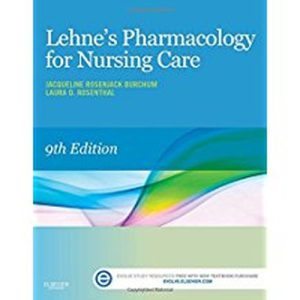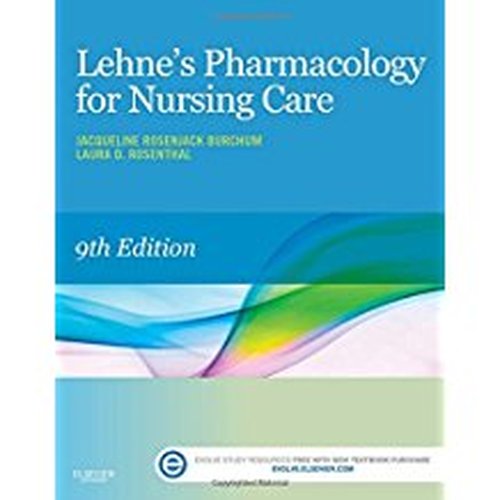Test Bank For Lehnes Pharmacology for Nursing Care Burchum 9th Edition
$55.00 Original price was: $55.00.$29.99Current price is: $29.99.
Test Bank For Lehnes Pharmacology for Nursing Care Burchum 9th Edition
This is completed downloadable of Test Bank For Lehnes Pharmacology for Nursing Care Burchum 9th Edition

Product Details:
- ISBN-10 : 0323371310
- ISBN-13 : 978-0323371315
- Author: Richard A. Lehne PhD (Author), Patricia Neafsey RD PhD (Author), Nancy Haugen PhD RN (Author), Vicky J. King (Author), James L. King (Author), Kathy Rose RN MSN (Author), Alan P. Agins PhD (Author)
Known for its clear explanations of drug prototypes and how they work, Lehne’s Pharmacology for Nursing Care, 9th Edition provides a solid understanding of key drugs and their implications for nursing care. A perennial student favorite, this book simplifies complex concepts, using large and small print to distinguish need-to-know drug content from the material that’s merely nice to know. New to this edition are quick-reference summaries of prototype drugs, safety alerts, and a strongerQSEN focus. Written by noted nursing pharmacology instructors Jacqueline Burchum and Laura Rosenthal, this text helps you understand pharmacology as opposed to merely memorizing drug facts.
Table of Content:
Chapter 06: Drug Interactions
Test Bank
MULTIPLE CHOICE
- The nurse is teaching a patient about taking warfarin and asks if the patient takes aspirin. This assessment by the nurse reflects a knowledge of which type of drug interaction?
| a. | Creation of unique effects |
| b. | Increased therapeutic effects |
| c. | Inhibitory effects |
| d. | Potentiative effects |
ANS: D
A potentiative effect is one in which one drug intensifies the effects of another. Both warfarin and aspirin suppress blood clotting, and the combination may increase the risk of bleeding, which is an intensified adverse effect. Creation of a unique effect is a rare occurrence in which the combination of two drugs creates a response not seen with either drug when given alone. Increased therapeutic effects are a type of potentiative effect; however, in this case the combination of two drugs would increase the desired effects. An inhibitory effect is a type of pharmacodynamic effect that occurs when an antagonist drug inhibits the action of an agonist drug at the same receptor site.
PTS: 1 DIF: Cognitive Level: Application REF: pp. 55-56
TOP: Nursing Process: Assessment
MSC: NCLEX Client Needs Category: Physiologic Integrity: Reduction of Risk Potential
- A young adult postoperative patient is receiving morphine 2 to 4 mg IV every 2 hours PRN pain. The last dose was 3 mg given 2 hours ago. The patient is asleep, and the nurse notes a heart rate of 86 beats per minute and a respiratory rate of 8 breaths per minute. Which PRN medication will the nurse give this patient?
| a. | Diphenhydramine [Benadryl] to counter morphine side effects |
| b. | Morphine 4 mg for increased pain, as indicated by tachycardia |
| c. | Naloxone [Narcan] to block the effects of the morphine |
| d. | Nothing at this time, because the patient is resting comfortably |
ANS: C
A respiratory rate of 8 breaths per minute indicates respiratory depression, which is a significant adverse effect indicating morphine toxicity. Naloxone blocks the actions of morphine at cell receptor sites and is given to quickly reverse the effects. This patient does not have signs of an allergic response, which would include shortness of breath, a rapid respiratory rate, and wheezing. The tachycardia might be a sign of worsening pain, but the toxic effects must be treated first. Patients who are sleeping are not always pain free.
PTS: 1 DIF: Cognitive Level: Analysis REF: p. 58
TOP: Nursing Process: Evaluation
MSC: NCLEX Client Needs Category: Physiologic Integrity: Reduction of Risk Potential
- In a discussion of drug-drug interactions, which would be the best example of a beneficial inhibitory interaction?
| a. | Naloxone [Narcan] blocking morphine sulfate’s actions |
| b. | Antacids blocking the action of tetracycline [Sumycin] |
| c. | Propanolol [Inderal] blocking the effects of albuterol |
| d. | Cholestyramine blocking the actions of antihypertensive drugs |
ANS: A
Naloxone is used when a narcotic overdose has occurred. As a narcotic antagonist, it provides a beneficial inhibitory interaction. An antacid blocking tetracycline’s antibiotic effects would not be beneficial, but rather detrimental to the desired effects of the tetracycline. Alcohol would not block the effects of opiates, but would contribute to CNS depression. Cholestyramine and certain other adsorbent drugs, which are administered orally but do not undergo absorption, can adsorb other drugs onto themselves, thereby preventing absorption of the other drugs into the blood.
PTS: 1 DIF: Cognitive Level: Application REF: p. 58
TOP: Nursing Process: Implementation
MSC: NCLEX Client Needs Category: Physiologic Integrity: Reduction of Risk Potential
- A patient is taking drug X and receives a new prescription for drug Y, which is listed as an inducing agent. The nurse caring for this patient understands that this patient may require ____ doses of drug ____.
| a. | lower; X |
| b. | lower; Y |
| c. | higher; X |
| d. | higher; Y |
ANS: C
An inducing agent stimulates the synthesis of CYP isoenzymes, which may increase the metabolism of other drugs as much as two- to threefold, thereby lowering the level of those drugs in the body and requiring higher doses to maintain drug effectiveness.
PTS: 1 DIF: Cognitive Level: Application REF: pp. 56-58
TOP: Nursing Process: Planning
MSC: NCLEX Client Needs Category: Physiologic Integrity: Pharmacologic and Parenteral Therapies
- A patient taking oral contraceptives thinks she may be pregnant. As part of this patient’s history, what will the nurse ask the patient?
| a. | “Do you drink grapefruit juice?” |
| b. | “Do you take seizure medication?” |
| c. | “Do you take your contraception with milk?” |
| d. | “Do you use laxatives regularly?” |
ANS: B
Patients taking oral contraceptives along with phenobarbital, which is used to treat seizures, will have lower levels of the contraceptive, because phenobarbital is an inducing agent, which causes an increase in the metabolism of oral contraceptives. Grapefruit juice inhibits the metabolism of some drugs, leading to toxic effects. Dairy products interfere with the absorption of tetracyclines, because the calcium binds with the drug to form an insoluble complex. Laxatives reduce the absorption of some drugs by speeding up the transit time through the gut.
PTS: 1 DIF: Cognitive Level: Analysis REF: pp. 59-60
TOP: Nursing Process: Diagnosis
MSC: NCLEX Client Needs Category: Physiologic Integrity: Reduction of Risk Potential
- A child ingests a parent’s aspirin tablets, and the prescriber orders sodium bicarbonate to block the toxic effects of the aspirin. The nurse caring for this patient knows that sodium bicarbonate is effective against the aspirin because it:
| a. | accelerates its passage through the intestine. |
| b. | alters urinary pH to enhance renal excretion. |
| c. | induces CYP isoenzymes to increase drug metabolism. |
| d. | raises the pH of the interstitial fluid to facilitate passage out of the cells. |
ANS: D
Sodium bicarbonate increases the pH of interstitial fluid and plasma, allowing the acidic aspirin ions to move outside the cells and thus removing them from the site where they have toxic effects. It does not have laxative effects and does not alter the rate of passage through the gut. It is not a CYP isoenzyme inducer and therefore has no effect on drug metabolism. It does not alter renal excretion of aspirin.
PTS: 1 DIF: Cognitive Level: Application REF: p. 56
TOP: Nursing Process: Implementation
MSC: NCLEX Client Needs Category: Physiologic Integrity: Reduction of Risk Potential
- Which statement about food and drug interactions is true?
| a. | Foods alter drug absorption and metabolism but not drug action. |
| b. | Medications are best absorbed on an empty stomach. |
| c. | Patient discomfort is the food and drug interaction of most concern. |
| d. | Some foods can inhibit CYP isoenzymes and alter drug metabolism. |
ANS: D
Grapefruit juice inhibits CYP3A4, which lowers the metabolism of some drugs, leading to toxic effects of drugs affected by these isoenzymes. Foods can alter all pharmacokinetic and pharmacodynamic processes. Not all medications are absorbed better on an empty stomach; some require certain foods to enhance absorption. Patient comfort is a concern, but it is not as important as more severe and possibly life-threatening food and drug interactions.
PTS: 1 DIF: Cognitive Level: Analysis REF: pp. 59-60
TOP: Nursing Process: Assessment
MSC: NCLEX Client Needs Category: Physiologic Integrity: Reduction of Risk Potential
- A nurse is teaching a patient about a prescription for a monoamine oxidase (MAO) inhibitor for depression. What will the nurse teach the patient to avoid while taking this drug?
| a. | Alcoholic beverages |
| b. | Aged cheeses |
| c. | Brussels sprouts and cabbage |
| d. | Grapefruit juice |
ANS: B
Aged cheeses are rich in tyramine, which interacts with MAO inhibitors to raise blood pressure to life-threatening levels. Patients taking MAO inhibitors should be taught to avoid tyramine-rich foods. Chianti wine contains tyramine, but other alcoholic beverages do not. Brussels sprouts and cabbage are foods rich in vitamin K, which can interfere with the effects of warfarin. Grapefruit juice inhibits CYP3A4 and interferes with the metabolism of many medications.
PTS: 1 DIF: Cognitive Level: Application REF: p. 60
TOP: Nursing Process: Implementation
MSC: NCLEX Client Needs Category: Physiologic Integrity: Reduction of Risk Potential
- A nurse is teaching a patient about a drug that induces P-glycoprotein. The nurse will explain that this drug may cause which effect on other drugs?
| a. | Decreased absorption in the intestines |
| b. | Decreased elimination through the kidneys |
| c. | Increased brain exposure |
| d. | Increased fetal absorption |
ANS: B
Drugs that induce PGP can increase drug export from cells of the intestinal epithelium into the intestinal lumen, thus decreasing absorption of the drug. PGP inducers also increase drug elimination and decrease brain and fetal drug exposure.
PTS: 1 DIF: Cognitive Level: Analysis REF: p. 58
TOP: Nursing Process: Assessment
MSC: NCLEX Client Needs Category: Physiologic Integrity: Pharmacologic and Parenteral Therapies
MULTIPLE RESPONSE
- The nurse is providing multiple medications to a patient whose spouse brings grapefruit juice every morning. The nurse will be concerned about which classes of drugs? (Select all that apply.)
| a. | Calcium channel blockers |
| b. | Selective serotonin reuptake inhibitors |
| c. | Aminoglycosides |
| d. | Beta blockers |
| e. | Penicillins |
ANS: A, B
Calcium channel blockers and selective serotonin reuptake inhibitors have been shown to reach increased and/or toxic levels when taken with grapefruit juice. Grapefruit juice is not contraindicated with aminoglycosides, beta blockers, or penicillins.
PTS: 1 DIF: Cognitive Level: Application REF: pp. 59-60
TOP: Nursing Process: Assessment
MSC: NCLEX Client Needs Category: Physiologic Integrity: Reduction of Risk Potential
- The nurse is administering morning medications. The nurse gives a patient multiple medications, two of which compete for plasma albumin receptor sites. As a result of this concurrent administration, the nurse can anticipate that what might occur? (Select all that apply.)
| a. | Binding of one or both agents will be reduced. |
| b. | Plasma levels of free drug will rise. |
| c. | Plasma levels of free drug will fall. |
| d. | The increase in free drug will intensify effects. |
| e. | The increase in bound drug will intensify effects. |
ANS: A, B, D
When two drugs bind to the same site on plasma albumin, coadministration of those drugs produces competition for binding. As a result, binding of one or both agents is reduced, causing plasma levels of free drug to rise. The increase in free drug can intensify the effect, but it usually undergoes rapid elimination. The increase in plasma levels of free drug is rarely sustained.
PTS: 1 DIF: Cognitive Level: Analysis REF: p. 56
TOP: Nursing Process: Diagnosis
MSC: NCLEX Client Needs Category: Physiologic Integrity: Pharmacologic and Parenteral Therapies
- A nurse is caring for a patient who is taking multiple medications. To help ensure that adverse drug reactions are prevented or minimized, the nurse will do which of the following? (Select all that apply.)
| a. | Ask the patient about over-the-counter medications used. |
| b. | Contact the prescriber to request cytochrome P450 levels. |
| c. | Limit the patient’s calcium intake. |
| d. | Obtain a thorough diet history. |
| e. | Request orders for PRN medications to treat any anticipated symptoms of drug interactions. |
ANS: A, B, D
Over-the-counter medications add to drug interactions, and a thorough history of all medications taken by the patient is essential to minimize adverse drug reactions. Cytochrome P450 levels yield important information about a patient’s ability to metabolize drugs and can help predict whether drugs will reach toxic levels or be ineffective. A diet history allows providers to anticipate significant known food-drug interactions. Limiting calcium intake is necessary only if the patient is taking drugs known to interact with calcium, such as tetracycline. Asking for PRN medications to treat drug reactions may only compound the risk, because the risk of drug interactions increases with the number of medications taken.
PTS: 1 DIF: Cognitive Level: Application REF: pp. 59-60
TOP: Nursing Process: Assessment
MSC: NCLEX Client Needs Category: Physiologic Integrity: Reduction of Risk Potential
- The prescriber has ordered an antibiotic for a patient with a bacterial infection. The nurse provides patient education at discharge and instructs the patient to take the drug on an empty stomach. When should the patient take the drug? (Select all that apply.)
| a. | 1 hour or more before a meal |
| b. | Only after an 8-hour fast |
| c. | Only after the patient has missed a meal |
| d. | At least 2 hours after a meal |
| e. | Shortly before a meal |
ANS: A, D
The absorption of some drugs can be significantly reduced by food; these drugs should be taken on an empty stomach, which is 1 hour or more before a meal or at least 2 hours after a meal. An 8-hour fast is not necessary; the patient does not need to miss a meal to take the medication; and it is not reasonable to have the patient on thin liquids for 12 hours.
PTS: 1 DIF: Cognitive Level: Application REF: p. 61
TOP: Nursing Process: Planning
MSC: NCLEX Client Needs Category: Physiologic Integrity: Pharmacologic and Parenteral Therapies
People Also Search:
lehnes pharmacology for nursing care burchum 9th edition
lehnes pharmacology for nursing care burchum
lehnes pharmacology for nursing care burchum 9th edition testbank download pdf
lehnes pharmacology for nursing care burchum 9th edition download scribd
Related products
Test Bank
Test Bank for Decision Support and Business Intelligence Systems, 9th Edition: Efraim Turban
Test Bank
Test Bank for Operating Systems: Internals and Design Principles, 7th Edition: William Stallings












